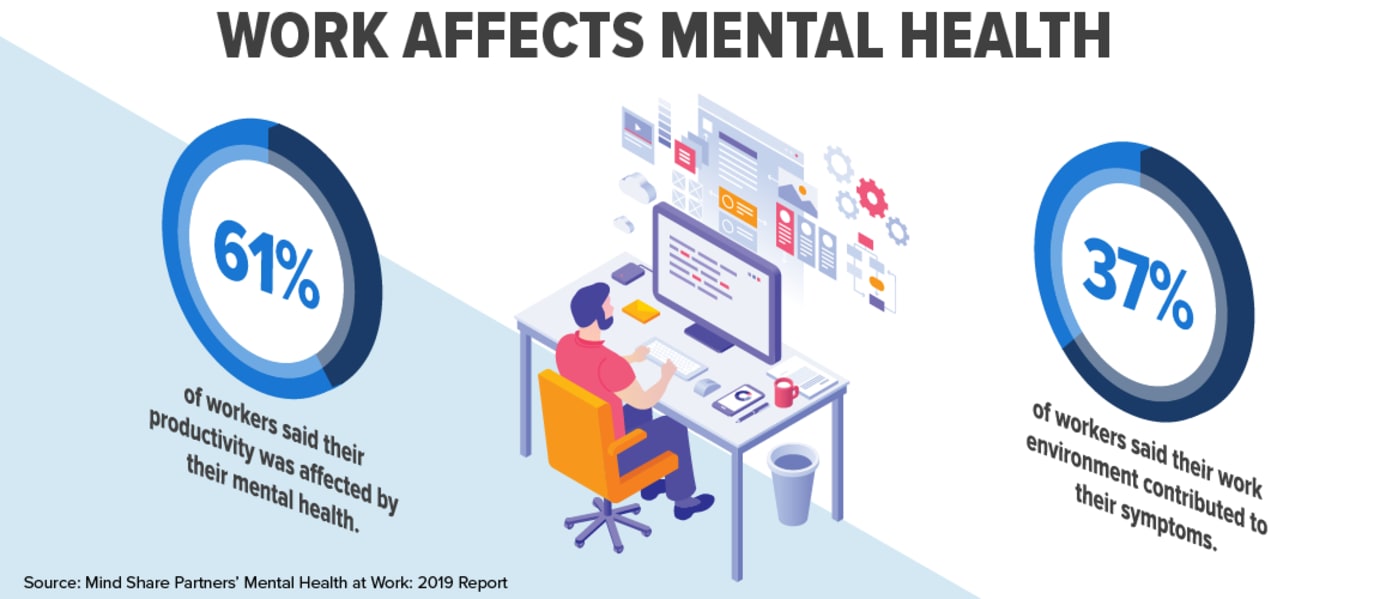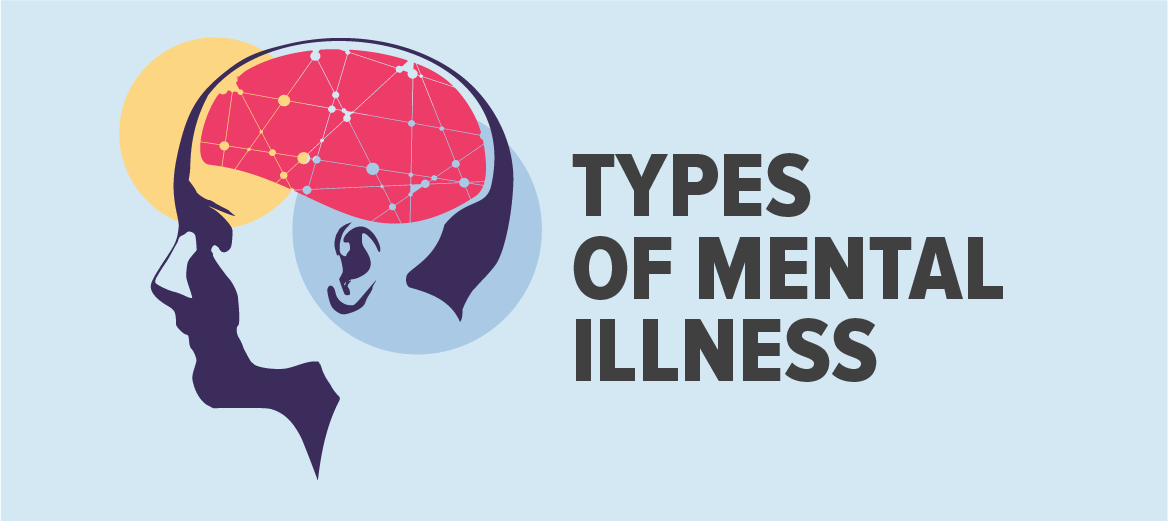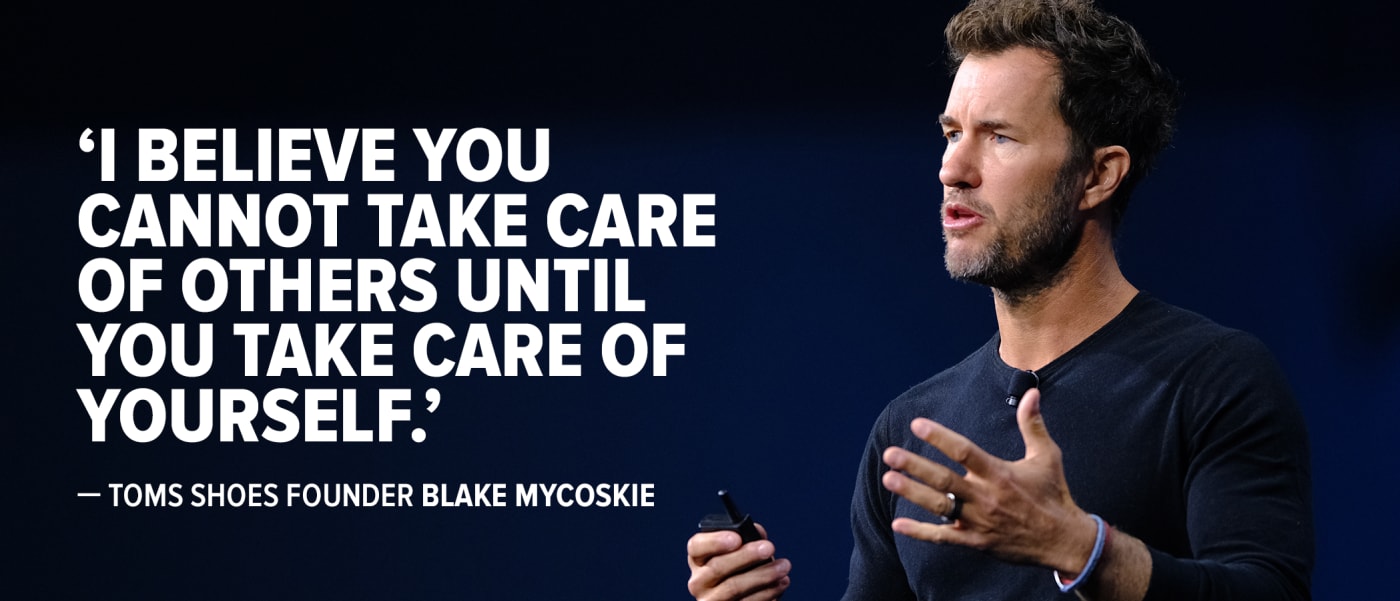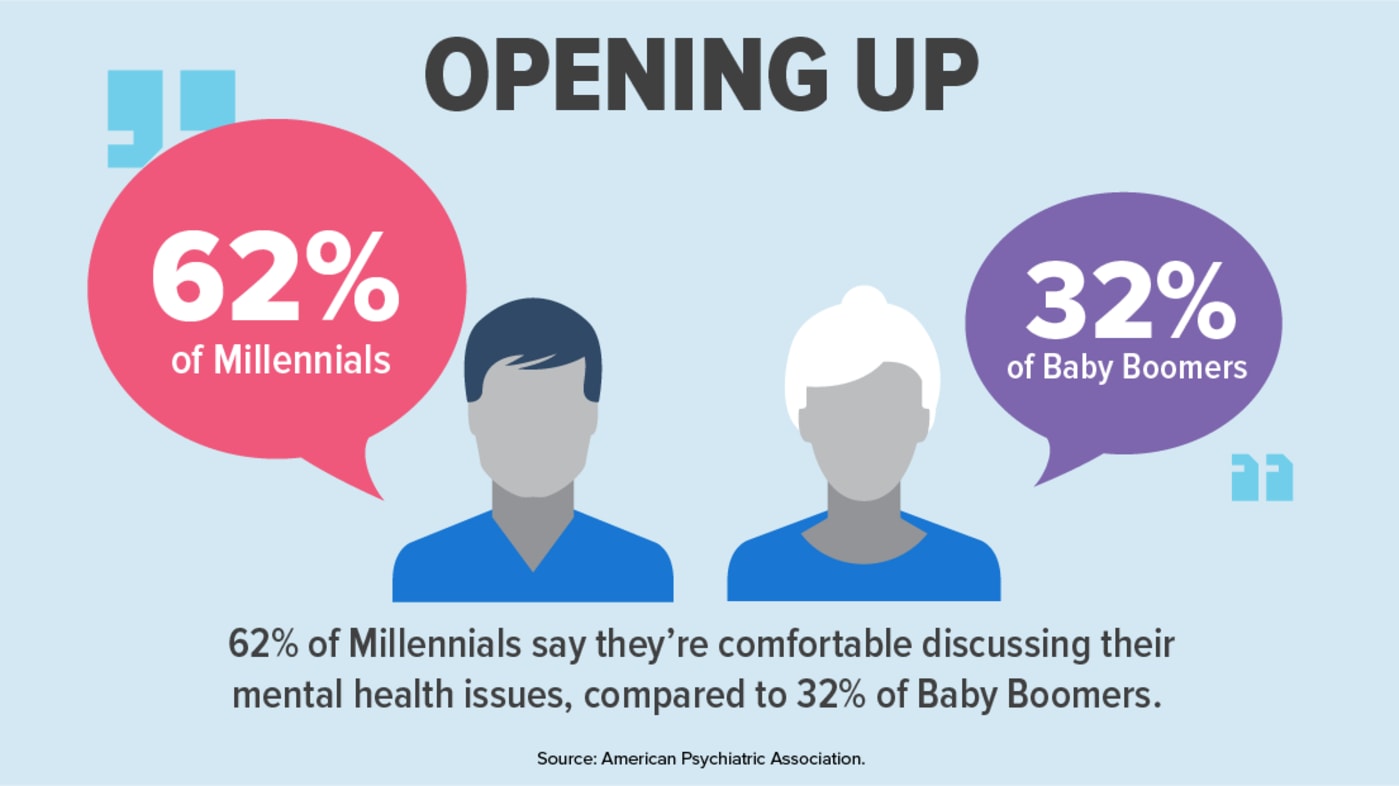Strategies to Manage Mental Illness at Work
Worry and stress caused by coronavirus highlights the need to support workers' mental health.

In 2019, 94 percent of U.S. employees reported experiencing work-related stress. Imagine what's happening now amid the coronavirus pandemic that is upending daily routines and sparking so much uncertainty.
COVID-19 has compounded workers' already-high anxiety levels, especially in certain hard-hit industries. Health care workers and first responders have a double burden: Not only must they care for nervous patients, but they are also at a heightened risk of being infected from those they treat. Retail workers are in danger of catching the virus from customers. Hotel and airline workers are suffering as the tourism industry goes dormant. Meanwhile, multiple states, including New York and California, have ordered bars and restaurants to close and workers in that industry are losing their jobs and livelihoods.
Nearly all employees across the globe are feeling the strain, however. People worry that they or someone close to them may become ill. They are unsettled by changes to their daily lives, with many companies telling employees to work from home. And they are worried about their finances as markets react to the ongoing crisis. Earlier this week, the Dow Jones Industrial Average shed nearly 3,000 points, or almost 13 percent—its worst day since Black Monday in 1987.
Evidence of dread is already apparent. Human resource executives report getting calls from employees unnerved by colleagues' sneezes and alarmed by co-workers' trips to Asia. Calls to employee assistance programs (EAPs) are up as much as 20 percent over the last few weeks, company executives said. "All the media exposure is causing a panic and a feeling of hopelessness," says Bert Alicea, executive vice president of EAP+Work/Life Services at Health Advocate, a patient advocacy and assistance company.
There is some good news for employees struggling with their mental health. Company leaders increasingly realize how important it is to help individuals address diseases like depression, anxiety and addiction. They are experimenting with numerous programs to provide aid and end the stigma. That support becomes even more critical in uncertain times.
Creating an Open Dialogue on Workplace Mental Health
Tech company Buffer has an entire Slack channel devoted to employees’ mental health. That’s where founder and chief executive Joel Gascoigne posts about his therapy appointments. Another employee shared that he was asking his doctor for an anti-anxiety medication, while a third broadcast his intent to start counseling sessions.
Buffer, a maker of social media management products whose workforce is entirely remote, prides itself on a culture of transparency, and that includes employees talking about all facets of their lives.
"It's hard to be the first to talk about mental health," says Courtney Seiter, director of people at Buffer. "To have someone like Joel say he's going to a therapist and what he's working on paves the way for someone else to say something about what they're going through."
Many companies are striving for at least some of that candor as they seek to increase awareness about mental illness and encourage more employees to seek treatment. Suicide rates nationally are climbing, workers' stress and depression levels are rising, and addiction—especially to opioids—continues to bedevil employers. Such conditions are driving up health care costs at double the rate of illnesses overall, according to Aetna Behavioral Health.
Starting workplace conversations about behavioral health is challenging. Such conditions are often seen as a personal failing rather than a medical condition.
A firm such as Buffer likely has an easier time addressing mental health issues than other companies given its employee demographics. Its founder is 32, which is also the average age of its 87 employees. As a Millennial, he's part of a generation whose members, along with those of Generation Z, are accustomed to broadcasting their lives on social media. Both generations also grew up in an era when children and teens were regularly diagnosed and medicated for conditions such as attention deficit hyperactivity disorder and therefore don't have the same negative associations with mental illness as their older counterparts. In fact, 62 percent of Millennials say they're comfortable discussing their mental health issues, almost twice as many as the 32 percent of Baby Boomers who expressed such ease, according to the American Psychiatric Association (APA).
"[Younger people] just lay things out on the line," says Selvi Springer, assistant director of medical accommodations at EY, a London-based professional services firm, which started a campaign to raise awareness of mental illness last year.
EY is not alone. Johnson & Johnson (J&J), the New Brunswick, N.J.-based pharmaceutical giant; Cigna, the Bloomfield, Conn.-based health insurer; and Garmin International, an Olathe, Kan.-based tech company, are among those with specific mental health programs for their employees. Approaches differ, though tactics include bulking up mental health services and teaching managers how to spot signs of behavioral illness. Providing access to therapists through nontraditional means such as texting is also a popular and pragmatic strategy, since the current psychiatrist shortage can make finding a professional for in-person counseling difficult.

The Center for Workplace Mental Health at the American Psychiatric Association Foundation reports that 77 percent of counties in the U.S. don't have enough psychiatrists. Reasons for the shortage include low reimbursement rates, burnout and administrative burdens. And according to a survey by Mercer, about 75 percent of employers with workforces of 5,000 people or more say access to behavioral health care is a concern in some or all of their locations. Fifty percent of all employers say they have enhanced their employee assistance programs, while just over one-third have implemented a tele-therapy program.
The Business Case for Mental Health: Costs and Opportunities
"Employers are getting more savvy on addressing mental health," says Darcy Gruttadaro, director of the Center for Workplace Mental Health at the American Psychiatric Association Foundation in Washington, D.C. "They understand the direct and indirect health care costs."
Mental health expenses jumped by more than 10 percent annually over five years, compared with an annual increase of 5 percent for other medical costs, according to a study conducted by Aetna Behavioral Health. Treating depression alone costs $110 billion annually, and half of that cost is shouldered by employers. Companies spent $2.6 billion on opioid addiction in 2016—an eightfold increase since 2004, the Kaiser Family Foundation reported last year.
Meanwhile, more people are taking their own lives. Suicide rates rose 33 percent, to 14 per 100,000 people up from 10.5 per 100,000 people, from 1999 through 2017, the last year for which figures were available, according to the Centers for Disease Control and Prevention. One reason: Many younger workers are stressed, depressed or anxious. In fact, the proportion of workers with symptoms of depression rose 18 percent from 2014 to 2018. Among members of Generation Z and Millennials, depression symptoms increased at an even faster rate, jumping 39 percent and 24 percent, respectively, according to New York City-based technology company Happify Health.
Most people's reluctance to discuss mental illness belies the diseases' prevalence. Nearly 1 in 5 U.S. adults experience some form of mental illness every year, the APA reports.
Such diseases cause changes in emotions, thinking or behavior that can lead to problems carrying out basic functions. Experts believe that mental illnesses are caused by genetic, social and environmental factors, or some combination. Anxiety and depression are among the most common conditions.
"We want people to understand that mental illness is not a character flaw," says Craig Kramer, a mental health awareness ambassador at J&J. "People should bring casseroles to people with mental illness just like they do for people with cancer."
 | ||
| | Anxiety Disorders
Anxiety is the uneasiness that individuals feel when thinking about a future event they fear won’t end well. But to be diagnosed with one of the several disorders such as a phobia, the fear must be out of proportion to the situation or age-inappropriate, while also hindering the patient’s ability to function normally. Individuals suffering from anxiety disorders often try to avoid situations that trigger or worsen their symptoms, potentially risking their job performance and personal relationships. Anxiety disorders are the most common type of mental illness, affecting nearly 30 percent of adults at some point in their lives.
Major Depressive Disorder
This condition affects how patients feel, think and act, and it can lead to a variety of emotional and physical problems. Symptoms include a loss of interest in once-enjoyed activities; changes in appetite; dwindling energy; feelings of worthlessness; and difficulty thinking, concentrating or making decisions. Symptoms may resemble those of grief and sadness. However, depression symptoms last for at least two weeks, while grief and sadness come in waves. Depression affects about 1 in 15 adults annually, and 1 in 6 people will experience it during their life.
Bipolar Disorders
Bipolar disorders are brain disorders that cause “mood episodes,” or extreme and intense emotional states that occur at distinct times and can cause changes in a person’s behavior, energy level and ability to function. Such episodes are generally interspersed with normal moods.
Schizophrenia
Schizophrenia is a chronic brain disorder that affects less than 1 percent of the U.S. population. Symptoms can include delusions, hallucinations, trouble with thinking and lack of motivation. Contrary to common perceptions, the condition does not cause a split personality or multiple personalities and most people with the disease are not dangerous or violent.
Post-Traumatic Stress Disorder
Experiencing or witnessing a traumatic event such as a natural disaster, a terrorist act, combat or a violent personal assault can lead to post-traumatic stress disorder (PTSD). Symptoms include intense, disturbing thoughts and feelings related to the experience that last long after the situation has ended. People with PTSD may feel sadness, fear or anger and may become estranged from others. Roughly 11 percent of the U.S. population will be diagnosed with PTSD in their lifetime.
Eating Disorders
People with eating disorders develop disturbing eating habits and become preoccupied with their food and body weight. People with anorexia nervosa and bulimia nervosa—common eating disorders—tend to be perfectionists with low self-esteem who are extremely critical of themselves and their bodies. They usually “feel fat” and see themselves as overweight, sometimes despite life-threatening semi-starvation. Eating disorders most often affect women between the ages of 12 and 35.
Addiction/Substance Abuse
Addiction is a complex brain disease manifested by compulsive substance use despite harmful consequences. People with addiction have an intense focus on using an item such as alcohol or drugs, to the point that it takes over their lives. They often forsake school, jobs and personal relationships to fuel their habit.
Source: American Psychiatric Association.
| |
| | | |
Overcoming the Stigma: Mental Health Disclosure at Work
In the workplace, mental illness remains a largely taboo subject.
A majority of employees—68 percent—worry that reaching out about a mental health issue could negatively impact their job security, according to a 2019 study by Businessolver, a West Des Moines, Iowa-based health benefits administrator. Although 50 percent of employees overall (and 60 percent of Millennial employees) reported having had a mental health lapse, only one-third of those employees reached out to their employer.
The stigma may be dissipating, however, as more people share their stories.
Toms Shoes founder Blake Mycoskie was diagnosed with mild depression five years ago, a revelation he made public for the first time in June at the Society for Human Resource Management 2019 Annual Conference & Exposition. He plans to launch a self-help toolkit next year "to help people live their best lives."
"I believe you cannot take care of others until you take care of yourself," Mycoskie said at the conference.
Michael Phelps, the most decorated Olympic athlete in history, has discussed his problems with depression and is featured in an ad campaign for a text therapy company. Britain's Prince William raised his behavioral health struggles and the importance of seeking help at the World Economic Forum in Davos earlier this year. His brother, Prince Harry, is working with Oprah Winfrey on a documentary series about mental health. And last year's suicides of chef and TV host Anthony Bourdain and designer Kate Spade highlighted the need to talk about and treat such conditions before tragedy strikes.
"We're in a moment," Kramer says, "and we can't let it pass."

Legal Protections and Mental Health Accommodations in Employment
Mental health conditions are covered under the Americans with Disabilities Act. That means employers must make reasonable accommodations for workers with such disorders to perform their responsibilities. However, employees must be willing to divulge their need for modifications.
Myriad laws protect medical privacy, and experts say individuals don't have to provide extensive details about their conditions.
"We don't need to know that you go for treatment or you're on a certain amount of drugs," says Jill Vaslow, managing director of global benefits and well-being at Cigna. "But the more we know, the more we can do."
Supervisors might think someone who's regularly late for work and misses deadlines is lazy. But when managers know that the individual is dealing with a mental health issue, they may be able to adjust the employee's schedule or allow the person to work from home, for example.
"If we don't know anything, we just know that you aren't doing your job," Vaslow says.
Companies are training their employees to be sensitive to signs of mental illness, such as noticing changes in someone's behavior. If a typically stellar employee's performance declines, supervisors might reach out to the individual to discuss the shift and remind the person of services provided by the company, such as an employee assistance program (EAP).
These aren't easy conversations to have, though employers are learning that they're necessary.
Sometimes employees get the discussions started. Kramer became a mental health awareness advocate after his daughter tried to kill herself as she struggled with an eating disorder. When he began sharing his story with colleagues, Kramer learned that many had their own experiences with behavioral health. Those discussions led to a groundswell to find ways to help employees and their families address mental health concerns.
In 2017, J&J created an employee resource group for mental health that now has about 1,500 members, or "diplomats," who provide resources to educate and support colleagues coping with behavioral ailments. Many have been trained on how to spot signs of problems among their staffs and to broach the topic with those who may be hurting. This year, J&J's human resource professionals and managerial-level staff will also learn how to spot potential signals and provide help.
"Our employees came out of the woodwork to help fix the system," Kramer says.
HR Storytellers
Support Systems
Nearly five years ago, an employee at Denver-based construction company RK Mechanical took his own life, shocking the company and pushing it to highlight the importance of mental health to its workers.
"We chose to make it a priority," says Gretchen Meyer, vice president of human resources for the firm. Meyer notes that such discussions are especially important in the male-dominated construction industry. That's because men are typically less likely to discuss their health and feelings than women. In addition, many construction workers are former military service members who may struggle with post-traumatic stress disorder tied to their combat experiences.
RK took a multipronged approach to emphasizing the importance of mental health, including hiring two wellness counselors and promoting the use of mantherapy.org, a website that uses humor to educate men about mental health and directs them to further resources.
The company also added members to its safety team and taught them that checking for security goes beyond just physical measures such as ensuring that equipment is functioning correctly. They take time to get to know the workers personally, asking questions about their lives and being sensitive to changes in their demeanors.

"We want the security officials engaged," Meyer says. "We want them out there saying, 'How are you today?' 'How can I help?' "
RK schedules regular lunch discussions about mental health topics, and signs around the office remind employees about the EAP. Recently, the company added a service that allows workers to text a counselor 24 hours a day if they need to talk.
"You need different approaches," Meyer says. "You want to give people as many ways to get help as possible."
Finding the right method to deliver the message is key, as Garmin's leaders discovered. When it was preparing to launch a campaign highlighting mental health in 2016, the company found that the topic trended poorly with some employees, especially Baby Boomers, says Haley Prophet, senior well-being specialist at the firm. "They said it had a stigma," she explains.
So Garmin opted to focus on the same issues using a banner of "resilience." For example, the staff developed "Adventures in Resilience: The Amazing Workbook," which uses a graphic-novel format to discuss mental health. The overwhelmingly male staff loved it. Garmin also holds regular discussions on mental health topics that concentrate on the science behind the conditions. "We talk about what's physically going on in the brain and the body," Prophet says. She adds that the approach especially appeals to the company's engineers, who make up 65 percent of the workforce.
At the mental health discussions, Prophet says, some employees will get up and tell stories about their own conditions.
"We're seeing more discussions and a culture shift," she says. "People are standing up to be advocates and saying they're not ashamed to talk about mental illness."
Explore Further
SHRM provides resources to help companies more effectively accommodate mental health issues in the workplace.
Resource Page: Coronavirus and COVID-19
Communicable diseases like coronavirus and the respiratory illness it causes, COVID-19, can bring a busy workforce to a standstill. Here are ways to prepare your workforce for the possibility of business closures, working from home, quarantines and other outcomes of a disease outbreak.
How to Accommodate Workers with Addiction and Mental Health Conditions
Working with, accommodating and supporting employees who struggle with alcoholism, substance abuse or mental health issues can be difficult due to the sensitive nature of the situation and the numerous employment laws that may be implicated.
Toolkit: Employing People with Mental Health Disabilities
Depression, bipolar disorder, anxiety disorders and other mental health impairments can rise to the level of disabilities under the Americans with Disabilities Act and thereby require employers to make accommodations for workers with such conditions.
Different Demographic Groups Experience Mental Health Challenges in Unique Ways
Inclusion initiatives should factor in depression, anxiety and other mental health issues.
HR Forms: ADA Reasonable Accommodation Checklist
When an employer has information that a disability may be interfering with an employee's ability to perform his or her job, these steps may be taken.
Toolkit: Managing Employee Assistance Programs
An employer-sponsored employee assistance program is a work-based intervention offering designed to identify and assist employees in resolving personal problems that may be adversely affecting their performance at work, such as marital, financial or emotional problems; family issues; or substance or alcohol abuse.



